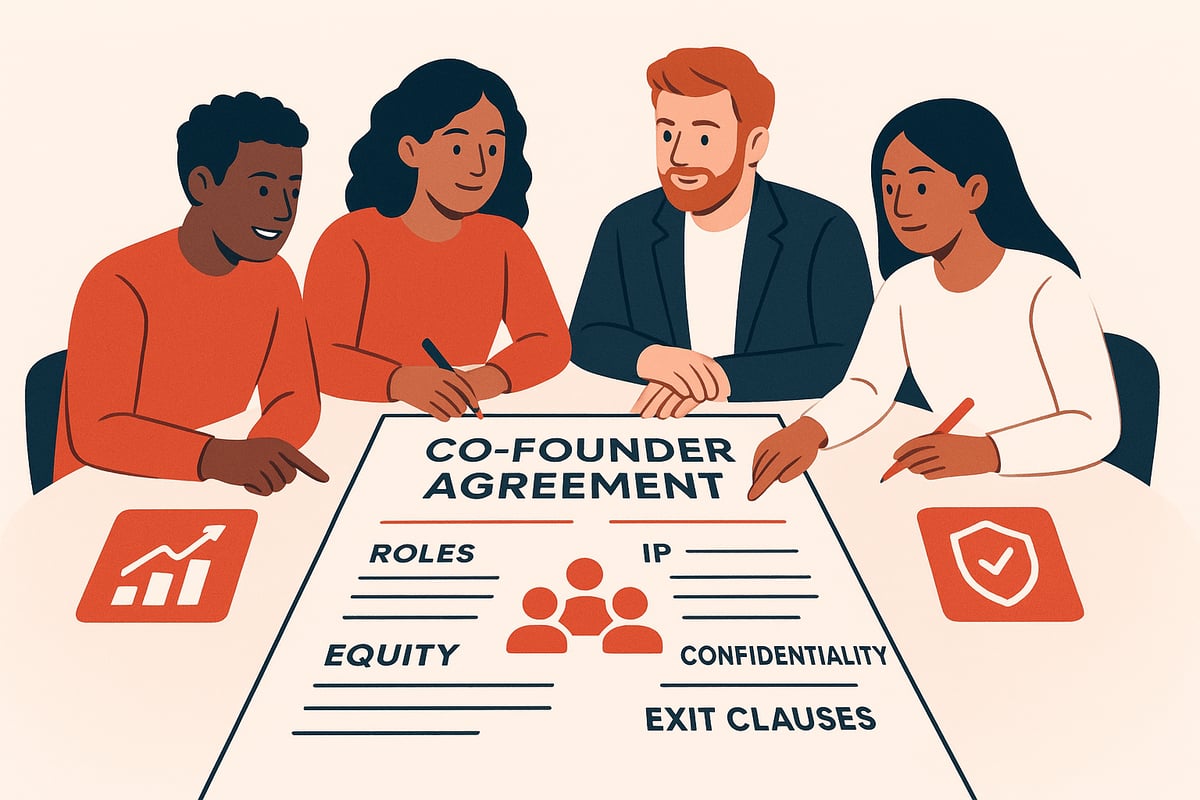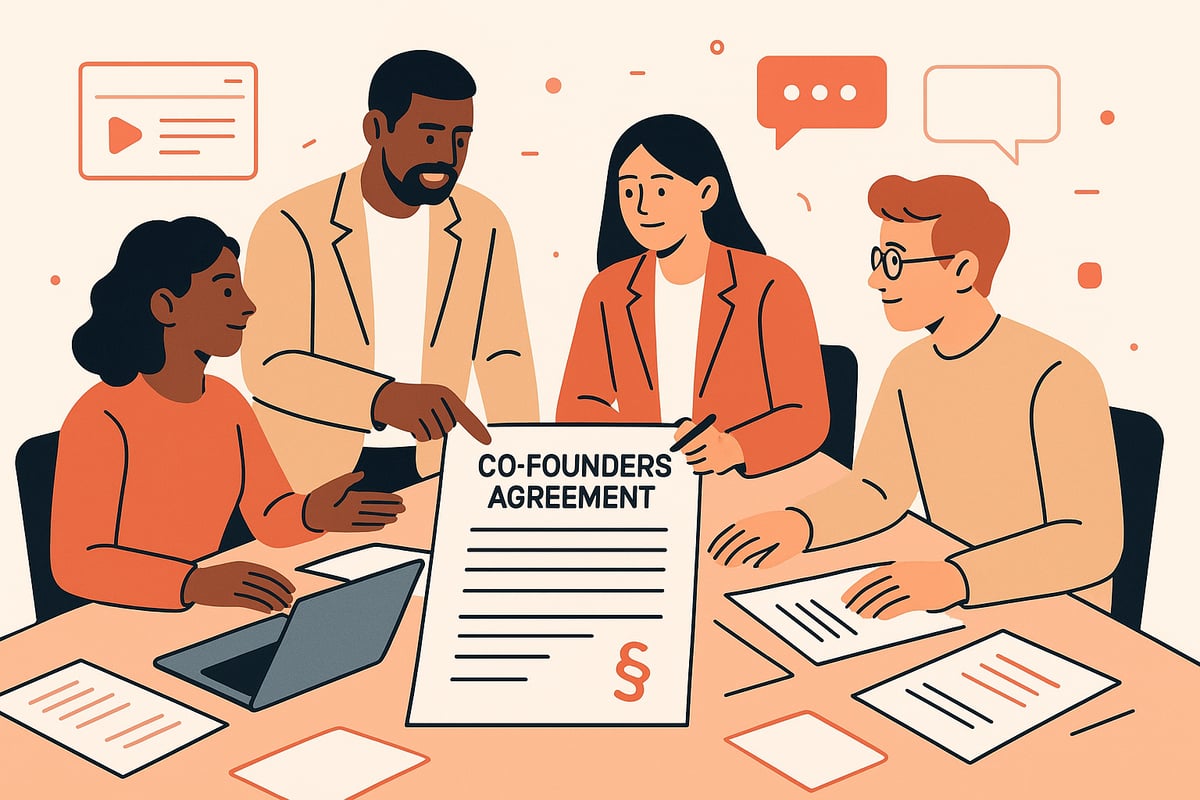Co Founders Agreement Guide: Essential Steps for 2025 Startups
Launching a startup is thrilling, filled with ambition and big ideas. Yet, without a clear co founders agreement, even the best plans can fall apart quickly.
A co founders agreement is your foundation, protecting your vision and partnerships from misunderstandings or disputes. This guide will walk you through every step needed to build a strong agreement for 2025.
You will discover why these agreements matter, what legal and business terms to include, how to negotiate fairly, and the latest updates for modern startups. Ready to secure your future and set your venture up for growth? Let’s dive in.
Why Every Startup Needs a Co-Founders Agreement in 2025
Launching a startup in 2025 is thrilling, but it comes with new complexities. Having a co founders agreement is no longer optional. It is the foundation that keeps founder relationships and business ambitions aligned.

Defining a Co-Founders Agreement
A co founders agreement is a formal contract between startup founders that outlines roles, equity, intellectual property, and dispute resolution. Unlike bylaws or shareholders agreements, which focus on broader corporate governance, a co founders agreement is tailored to the founding team's unique needs.
This document is not just a handshake or informal promise. It is legally binding and critical for protecting each founder’s interests. For a deeper dive into what makes a strong agreement and why it matters, check out the Founders agreement essentials.
Documenting roles, responsibilities, and ownership early helps founders avoid costly misunderstandings. Imagine two co founders launching an app—without a written agreement, confusion over who owns the code or who leads product decisions can quickly spiral into conflict.
Risks of Skipping the Agreement
Skipping a co founders agreement exposes startups to serious risks. Common pitfalls include:
- Disputes over equity splits and contributions
- Unclear intellectual property ownership
- Messy founder exits without clear protocols
Real-world stories abound of promising startups derailing because founders did not clarify expectations. For instance, one team lost their main product when a departing founder claimed ownership, stalling the company’s growth.
The data is sobering. According to Clara.co, over 65% of startup failures are linked to founder conflict. Without a co founders agreement, you risk your business being another statistic.
Evolving Startup Landscape in 2025
The startup world in 2025 looks very different from just a few years ago. Teams are often remote, with co founders scattered across borders and time zones. Investors have become more diligent, asking for detailed agreements before committing funds.
Regulatory environments have also shifted, especially for startups with international founders. Updated co founders agreements are now essential for addressing these trends, ensuring compliance, and keeping all stakeholders on the same page.
Startups that ignore these shifts risk legal trouble and missed funding opportunities. A current, well-structured agreement is your best safeguard in today’s landscape.
Benefits of a Comprehensive Agreement
A comprehensive co founders agreement delivers advantages that go beyond legal protection. Here are key benefits:
| Benefit | Impact on Startup |
|---|---|
| Legal protection | Shields all founders |
| Streamlined decision-making | Reduces internal friction |
| Increased investor confidence | Eases funding conversations |
| Long-term business stability | Supports sustained growth |
With a clear co founders agreement, founders resolve conflicts faster, attract investor trust, and create a stable foundation for scaling. The right agreement is not just paperwork—it is a critical tool for startup success.
Essential Components of a Co-Founders Agreement
A well-structured co founders agreement is the foundation for a successful startup partnership. Each component plays a vital role in protecting founders, clarifying expectations, and ensuring long-term stability. Let’s break down the essentials every 2025 startup should include.

Roles, Responsibilities, and Decision-Making
Defining each founder’s role is the first critical step in a co founders agreement. Clear job titles, such as CEO or CTO, set expectations for leadership and daily tasks. Outlining responsibilities ensures everyone knows who manages product, operations, or fundraising.
It’s also important to specify decision-making authority. Will some decisions require a majority vote or unanimous agreement? Deadlock resolution mechanisms, like appointing an external advisor, can prevent costly standstills.
For example, the CEO may lead strategy while the CTO oversees technology. Documenting these details helps avoid confusion and keeps your startup moving forward.
Equity Split and Vesting Schedules
How you divide ownership can make or break a team. A co founders agreement should lay out an equity split that reflects each founder’s contribution, experience, and commitment.
Vesting schedules protect the company if someone leaves early. Common structures include a four-year vesting period with a one-year cliff. This means no equity vests until the first year is complete, then monthly or quarterly vesting begins.
Unvested shares are typically returned or redistributed if a founder departs before the schedule is complete. According to recent trends, over 70 percent of startups use structured vesting for fairness and retention.
Intellectual Property (IP) Ownership and Assignment
Assigning IP to the company is non-negotiable in a co founders agreement. All founders should transfer any relevant inventions, code, or business concepts to the business entity at formation.
This ensures the startup owns its core assets and avoids disputes later. A typical IP clause might read:
All intellectual property created or contributed by any founder related to the company’s business shall be assigned to the company upon formation.
Having this language in writing protects your technology and brand as the company grows.
Capital Contributions and Financial Obligations
Startups need resources to get off the ground. Your co founders agreement should document each founder’s initial and future capital contributions, whether cash, equipment, or services.
A simple table can clarify commitments:
| Founder | Cash ($) | Assets | Services |
|---|---|---|---|
| Alex | 10,000 | Laptop | Marketing |
| Jamie | 5,000 | IP | Development |
Address how additional funding needs will be handled and what happens if more capital is required. This transparency helps prevent misunderstandings and financial strain down the road.
Confidentiality, Non-Compete, and Non-Solicitation
Protecting sensitive information is crucial for any startup. A robust co founders agreement will include confidentiality clauses to keep business secrets safe. Non-compete and non-solicitation terms stop founders from taking ideas or talent to a competitor.
For a deeper dive into essential clauses like these, review the key clauses in co-founder agreements, which outline what needs to be covered for 2025 success.
These provisions safeguard your intellectual property and team, even if a founder moves on.
Exit Clauses, Resignation, and Removal
Every co founders agreement needs clear rules for what happens when a founder leaves, whether by choice or necessity. Outline procedures for voluntary resignation, involuntary removal, and how to calculate buyback rights for equity or IP.
These clauses help maintain company stability and reassure investors that the business can survive transitions. For example, if a founder resigns, the company may have the right to repurchase their shares at fair market value.
Addressing exits upfront protects everyone and keeps the focus on growth.
Step-by-Step Process to Draft a Co-Founders Agreement
Creating a co founders agreement can feel daunting, but breaking it into clear steps makes the process manageable. Here is a practical, step-by-step approach every startup can follow to build a strong foundation for their future.

Step 1: Open Communication and Alignment
The first step in drafting a co founders agreement is to ensure all founders are aligned on vision, values, and goals. Open communication lays the groundwork for trust and transparency.
Consider scheduling a founder retreat or workshop to openly discuss expectations, strengths, and potential concerns. Use collaborative tools like shared documents or whiteboards to document these discussions.
Key topics to cover include long-term vision, individual motivations, and possible deal-breakers. This step helps prevent misunderstandings later and ensures that the co founders agreement truly reflects everyone’s intentions.
Step 2: Define Key Terms and Structure
Once alignment is achieved, the next step is to outline the main terms of your co founders agreement. Create a checklist of essential points, such as roles, equity splits, vesting schedules, intellectual property, and capital contributions.
A structured approach helps ensure nothing is overlooked. Many startups use template-based checklists to guide this phase. Consider summarizing agreed details in a simple table for clarity:
| Term | Founder A | Founder B | Founder C |
|---|---|---|---|
| Role | CEO | CTO | CMO |
| Equity (%) | 40 | 40 | 20 |
| Vesting | 4 yrs, 1 yr | 4 yrs, 1 yr | 4 yrs, 1 yr |
This clear structure forms the backbone of your co founders agreement.
Step 3: Legal Consultation and Customization
Every startup’s needs are unique, so customizing your co founders agreement is critical. Engage a startup lawyer familiar with the latest 2025 regulations to review and adapt your draft.
Avoid generic, one-size-fits-all templates. Instead, discuss your specific business model, industry risks, and founder backgrounds. For more detailed guidance, reference resources like Legal considerations for co-founder agreements.
This step ensures your co founders agreement is compliant, comprehensive, and tailored to your company’s future.
Step 4: Drafting and Iteration
With legal guidance, begin drafting the initial version of your co founders agreement. Include all agreed-upon terms and be as specific as possible.
Share the draft with all founders for review. Encourage honest feedback and use collaborative editing tools to track changes. If disagreements arise, revisit earlier discussions or seek mediation to resolve issues.
Iterative drafting ensures the final co founders agreement is robust and accepted by everyone involved, setting a positive tone for future collaboration.
Step 5: Formalization and Execution
After reaching consensus, it’s time to formalize your co founders agreement. Decide whether to use physical signatures or e-signature platforms, both are widely accepted in 2025.
Depending on your jurisdiction, you may need to notarize the document or file it with local authorities. Make sure each founder receives a fully executed copy for their records.
This step gives your co founders agreement legal standing and demonstrates professionalism to potential investors or partners.
Step 6: Ongoing Review and Updates
A co founders agreement is not static, it should evolve as your startup grows. Schedule regular reviews, at least annually or after major milestones like funding rounds or team changes.
Stay proactive by updating the agreement to reflect new realities, such as adding new founders or changing equity splits. This keeps your co founders agreement relevant and effective, supporting long-term business stability.
A living agreement ensures your team remains protected and aligned as your company scales.
Common Challenges and How to Overcome Them
Launching a startup is never a smooth ride. Even with a solid co founders agreement, teams can hit rough patches that test their resolve and structure. Let’s break down the most common challenges founders face and how to effectively overcome them.

Equity Disputes and Founder Departures
Disagreements over equity can quickly sour relationships, especially if co founders agreement terms are unclear. Founders may feel their contributions are not fairly valued, or disputes may arise when a founder leaves early. Vesting schedules can help, but mediation or arbitration is sometimes needed to resolve deep-rooted conflicts.
A structured approach makes all the difference. Using tools like the Co-founder equity split calculator helps set transparent expectations from day one. If a founder exits before fully vesting, the agreement should outline how shares are redistributed, ensuring fairness for all parties.
Decision-Making Deadlocks
When founders share equal voting power, stalemates can happen. These deadlocks can delay key business moves and damage team morale. The co founders agreement should include tie-breaker clauses, such as bringing in an external advisor or rotating leadership for tough calls.
Did you know that 30% of startups report decision deadlocks within their first two years? Clearly defined voting rights and dispute resolution processes keep your company agile and prevent costly standstills.
IP and Confidentiality Breaches
Protecting intellectual property is critical for any startup. Without clear terms in the co founders agreement, founders risk losing control of core assets if someone leaves. Confidentiality and non-compete clauses are vital to prevent misuse of ideas or client lists.
If breaches occur, mediation or arbitration is often a faster, less expensive solution than court. Regularly review your agreement to ensure all IP is properly assigned to the company, reducing the risk of future disputes.
Adapting to Regulatory and Market Changes
The legal landscape for startups changes rapidly. New regulations or market conditions can make parts of your co founders agreement outdated. For example, remote teams or cross-border founders may require new compliance measures.
To stay on track, schedule periodic agreement reviews and consult legal experts who understand current startup laws. Keeping your agreement updated ensures your business remains protected and adaptable as it grows.
Key Legal and Practical Updates for 2025 Startups
Staying ahead in 2025 means understanding the latest shifts impacting your co founders agreement. As the startup world evolves, founders must adapt their agreements to reflect legal, investor, and operational changes. Here are the key updates every founder should know.
New Regulatory Requirements and Best Practices
In 2025, regulatory changes are reshaping how co founders agreement documents are drafted. Startups now face stricter rules regarding cross-border teams, digital signatures, and transparency. For example, agreements must specify jurisdiction and choice-of-law when founders live in different countries.
Key best practices include:
- Clearly assigning IP rights to the company
- Using secure e-signature platforms
- Regularly updating agreements after funding rounds
Reviewing the Legal basics for startups helps ensure your co founders agreement meets all current legal standards and avoids costly compliance mistakes.
Investor Expectations and Due Diligence
Investors in 2025 expect a robust co founders agreement before considering funding. They look for provisions that clarify equity splits, vesting, anti-dilution, and liquidation preferences. These clauses protect both founders and investors during growth or exit events.
According to Co-founder equity distribution trends 2025, conditional vesting terms and transparent decision-making processes are now standard. Well-prepared agreements speed up due diligence and can boost your valuation.
Remote and Hybrid Team Considerations
Remote and hybrid teams are now the norm for many startups. Your co founders agreement must address how decisions are made asynchronously and how IP rights are managed across borders.
Founders should agree on digital collaboration tools, set clear guidelines for accessing confidential information, and outline dispute resolution processes suitable for distributed teams. Including these considerations ensures everyone stays aligned, no matter where they are.
Technology Tools for Agreement Management
Managing a co founders agreement is easier than ever with the right tech stack. Startups increasingly use secure e-signature platforms and cloud-based storage for document management.
Essential tools include:
- E-signature platforms for fast, legally binding execution
- Version control for tracking agreement updates
- Secure data rooms for sharing with investors and advisors
Embracing these tools keeps your co founders agreement accessible, up-to-date, and protected as your company scales.
Frequently Asked Questions About Co-Founders Agreements
Curious about co founders agreement essentials? Here are the answers to the most common questions founders ask before drafting or signing one. These insights will help you navigate your startup journey with confidence and clarity.
What’s the difference between a co-founders agreement and a shareholders agreement?
A co founders agreement is created at the very start of a business, often even before the company is officially incorporated. It focuses on the relationship between founders, spelling out roles, responsibilities, and what happens if someone leaves. In contrast, a shareholders agreement is broader, covering all shareholders, not just founders, and often deals with voting rights, share transfers, and protections for minority investors.
| Aspect | Co-Founders Agreement | Shareholders Agreement |
|---|---|---|
| Timing | Pre- or post-incorporation | Post-incorporation |
| Focus | Founder roles, IP, equity, exits | Shareholder rights, voting, transfers |
| Parties involved | Founders only | All shareholders |
For a deeper look at founder relationships and roles, see Co-founder roles and dynamics.
When should a startup create a co-founders agreement?
Ideally, you should draft a co founders agreement before your company is incorporated or as soon as you decide to work together. Early agreement helps prevent misunderstandings over equity, roles, and vision. If you delay, you risk costly disputes or misaligned expectations.
Startups that create a co founders agreement early experience 50% fewer founder conflicts, according to PandaDoc. Building a strong foundation from the beginning is essential, as highlighted in Building strong startup teams.
What happens if a founder leaves before vesting is complete?
If a founder leaves before their equity is fully vested, the unvested shares usually return to the company or are subject to a buyback by the remaining founders. This process protects the startup and ensures only active contributors benefit from full ownership.
A standard arrangement is a 4-year vesting schedule with a 1-year cliff. If a founder exits after 10 months, they walk away with nothing. If they leave after 18 months, they keep the portion that has vested, and the rest is redistributed or held by the company. This is why a clear co founders agreement is critical.
Can a co-founders agreement be amended?
Absolutely, a co founders agreement is a living document. As your business grows, you may need to add new founders, adjust equity splits, or clarify roles. Amendments typically require unanimous written consent from all founders, ensuring everyone remains aligned.
When making changes, always document updates in writing and have all founders sign the amendment. This flexibility allows your co founders agreement to evolve alongside your startup, supporting long-term success.
Now that you’ve got a clear roadmap for building a strong co founders agreement in 2025, remember you don’t have to navigate these challenges alone. At Swisspreneur, we know how valuable it is to connect with others who’ve walked the same path—people who can share insights, offer support, and even open doors. If you’re ready to take your next step and surround yourself with like minded Swiss founders, why not join our growing community You’ll find inspiration, advice, and collaboration opportunities that can make all the difference. Apply to our swiss founders community

